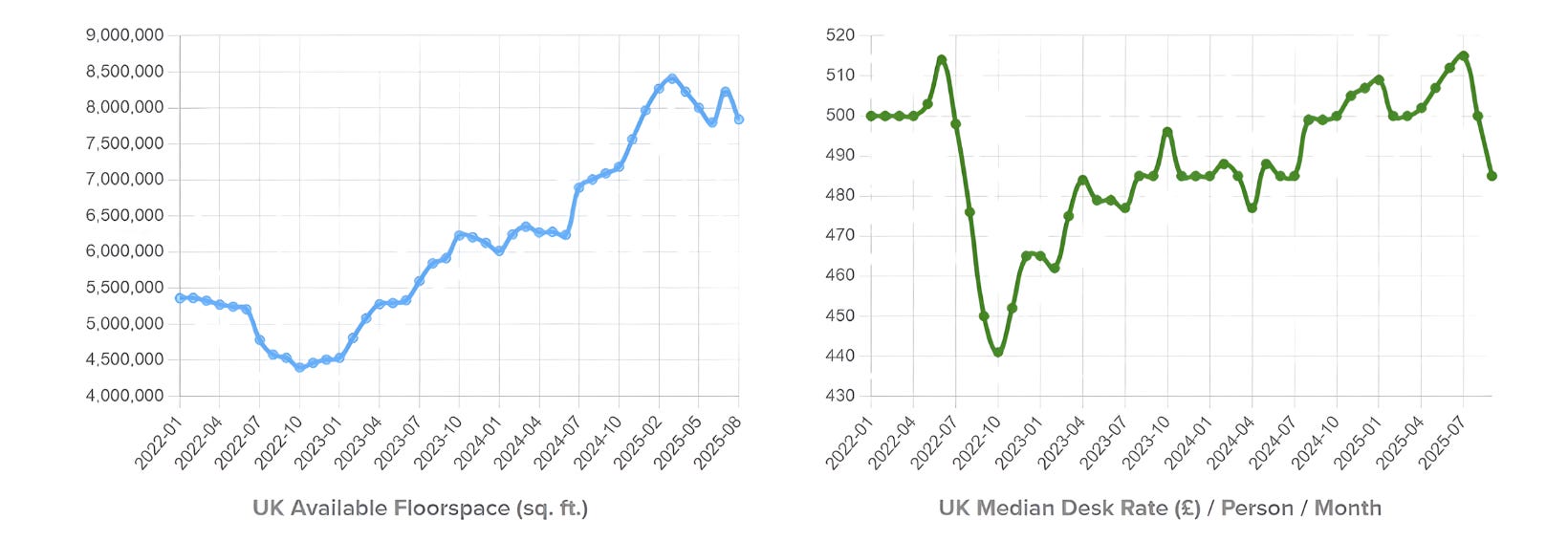Flex Is the Backbone of the Brave Economy: Why Businesses Are Doubling Down in Uncertain Times
Part 1 of 4 · Q3 Rubberdesk Report: Flex Is the Backbone of the Brave Economy
The economy may be uncertain, but bold businesses are not waiting for stability, they are building it. And they are doing it through flexible office space.
The data speaks volumes
Rubberdesk’s Q3 2025 report reveals a market that is not just resilient but accelerating. Available flexible office space dropped 2.3% to 7.75 million SqFt, with take up in London driving stock down 5.8% and prices up 0.8% in the past quarter, even as the national median desk rate fell 5.3% to £485.
That is a signal.
Demand is high, and flex is no longer just a fallback, instead, flex is the foundation of the brave economy, an economy built on resilience and adaptability.
Why?
In times of uncertainty, adaptability becomes a competitive advantage. Flexible workspace allows companies to pivot quickly, scale up or down, and respond to market shifts without the long term commitments of legacy leases.
Hybrid work is now a permanent part of the landscape.
Flexibility offers the infrastructure to support widespread teams and evolving business needs. With OfficeRnD reporting that 42% of European companies plan to increase their use of flexible workspace, the shift in mindset is obvious.
If flexibility is rising while prices are falling,
what does that say about where value is being created?
Businesses are prioritising freedom. They want to grow, test, and move.
And Flex is enabling that freedom.
Why flex matters more than ever
Value is no longer measured by square footage.
It is measured by agility.
Traditional leases tie companies down for years, with no capacity to resize as business needs evolve.
From fluctuating demand, global supply chain disruptions, and rapid technological change, businesses have plenty of challenges and uncertainty to deal with.
So why would a rigid workspace solution ever meet an agile business need?
Flex as a value add
Flexible office spaces are not just about desks and chairs anymore.
They offer wellness amenities, outdoor spaces, community breakfasts, and events. They fill a hospitality gap for businesses and create great places to work, which in turn both retains and attracts talent.
When a business looks for new flex office space, they often seek an operator that aligns with their brand, quality, and values. When brand alignment works, it can amplify a company’s market presence and culture.
The economics behind it all
The numbers tell a compelling story. .
A 2.3% drop in available space signals tightening supply, even as desk rates decline. This is a market maturing beyond price wars.
Businesses do not necessarily want the cheapest option.
They want the smartest and most adaptable one. After all, there is no point paying for an office that no one wants to come to.
Lower rates make flex even more attractive, but the real driver is strategic value. Every pound saved on a long term lease can be redirected towards talent, technology, or market expansion.
And let us not overlook risk mitigation.
If a market contracts, businesses can downsize without worry.
If it expands, they can scale without hesitation. That is not just convenience. That is what resilience is all about.
Flex and the future of work
With a decade of unprecedented change in how knowledge workers operate, it is hard to forecast the future of work. What we have seen is that flex workspace is agile and operates at the same velocity as its member businesses.
That agility is what has driven the huge growth in the sector.
This flexible office space model also unlocks wider talent pools. Companies can hire the best person for the job, regardless of geography, because their workspace strategy is not necessarily tied to one fixed location.
What does this mean for business leaders?
The message is clear, flexibility is essential.
The brave economy rewards those who embrace change, and flex office space is key to making that possible.
For businesses with distributed operations or those targeting regional markets, the 6.7% rate decline outside London creates compelling opportunities.
Regional cities offer quality flex space at less than half London’s cost (£280 vs. £629 per desk), with inventory growth providing choice and negotiating leverage.
Growing companies like HelloFresh are using flexible office space to manage rapid expansion and attract top talent, while enterprise companies like Amazon, Deloitte, and PwC are using it as part of their global real estate strategy within their broader real estate portfolio.
As we move into 2026, it is safe to expect the flex market to evolve even further.
Businesses that act now will reap the rewards, and those that hesitate risk being left behind in a market where being able to pivot is the difference between sink and swim.
The bottom line
The brave economy is not about waiting for things to calm.
It is about building businesses that can weather the storm. Flexible office space is key to that process, the foundation on which it can be built.
In a world where change is the only constant,
can you afford to tie yourself down?
Published exclusively in partnership with early access to Rubberdesk’s Q3 2025 report.






